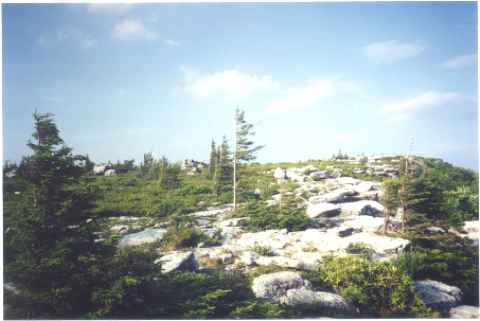 |
|
|
|
Fruit of the Bog |
NOTE: Download time for the photos below is long, but well worth it!
The mention of fruit often brings to mind trees bearing apples, peaches, pears, and plums. There are also many small fruits such as grapes, figs, kiwi, raspberries, blackberries, blueberries and cranberries. Clearly, the smaller fruits require less space than fruit bearing trees. Blueberries and cranberries are two small fruits, which I find to be particularly interesting.
Blueberries and cranberries have value as a landscape plant and they provide a great food source for wildlife. The fruits are also quite tasty for human consumption. They may be eaten fresh or easily frozen. These plants are native to various regions of North America and work well in areas of special needs, particularly "boggy" or marshy areas.
The blueberry is a deciduous woody plant that has interesting winter branching and attractive summer foliage, with a profusion of fruit in June. Blueberries are the truest of the "acid loving" plants, tolerating a pH of as low as 3.5. A pH this low would be lethal to all other landscape plants, including the "acid loving" azaleas, rhododendrons, dogwoods, and magnolias, which prefer a pH between 5.5 and 6.0 - no lower than 5.0.
The blueberry should be planted in reasonable garden soil with an abundance of peat moss, which is acidic, as a soil amendment. Don't be bashful, drive that pH down. They must have a uniform level of moisture, avoiding dehydration. The addition of high levels of peat moss will aid in this moisture retention. A spring feeding of HollyTone is beneficial in maintaining the health of the plant and producing fruit.
Cranberries are found in "boggy" areas and make a great evergreen ground cover for wet areas in the landscape. The foliage consists of compound boughs sporting small green leaves which have an attractive red color in the fall and winter. The foliage reminds me of the candytuft plant. The cranberries are produced in September. The cranberries can be planted on 3 foot centers for ground cover.
Blueberries and cranberries will also grow in normal garden soil as long as you provide the peat moss and maintain an even level of moisture, never allowing dehydration.
Now for the travelogue...
 |
|
|
 |
|
|
Dolly Sods is located in north central West Virginia as part of the U.S. Forestry Dept. According to my brother, scientist extraordinary, many millions of years ago this formation was the floor of the ocean. The African plate collided with the North American plate on the ocean floor causing this massive upheaval of rock formation. We think of sandstone as being soft, but sandstone which has been exposed to the elements is extremely hard.
Low lying areas of this sandstone base will not drain and a "bog" is created. The lower lying area in the "Cranberry" photo above has a flora of peat, cranberries, and "sun dews". "Sun dews" are best described as tiny little Venus Flytraps.
The region is phenomenal. Should you wish to visit Dolly Sods, type "Dolly Sods" into a search engine and you will find plenty of information. The public frequents this area to pick wild blueberries in June and cranberries in September. "Car camping" is available with fire pits and a central rest room. The road on top of the ridge is straight and narrow for miles. It is very cold on the ridge so you must take blankets, even in July. As with any camping, be respectful of nature. This area is one of the most amazing that I have ever seen.
Andy Lynn